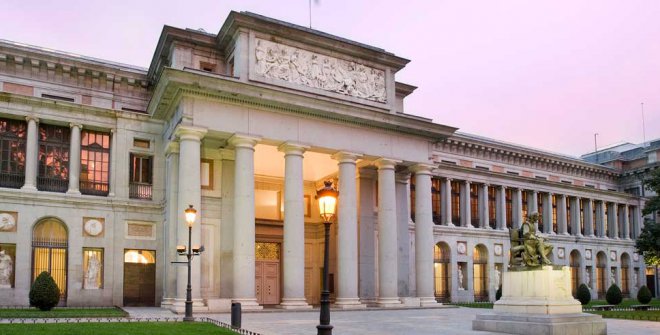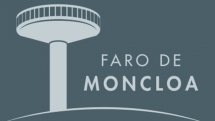24 hours in Madrid
Do you only have one day to take in the city of Madrid? We’ve got you covered! Our guide to spending 24 hours in the capital of Spain has plenty of suggestions for the morning, afternoon, evening and late night. Choose the activities and attractions you like best and enjoy. You’ll surely come back for more.
IN THE MORNING
Prado Museum
The superb Prado Museum is regarded by many to have the finest art in the world. It houses works belonging to the Spanish Royal collection, including paintings by Rogier van der Weyden, Hieronymus Bosch, Rubens, Fra Angelico, El Greco and Titian, among other artists. However, the Museum stands out for the masterpieces of two of the greatest Spanish painters: Velázquez and Goya. Choose your favourite artist and focus on their paintings or take a tour through the 10 Prado Museum highlights. In 2021, the Paseo del Prado and Buen Retiro, a landscape of arts and sciences, also known as the Landscape of Light, was declared a UNESCO World Heritage Site.

Reina Sofía Museum (MNCARS)
If you prefer to visit a modern and contemporary art museum, we recommend the Reina Sofía Museum, which tells the story of Spanish and European art from the historical avant-garde movements to the present, with a core focus on Guernica, one of Picasso’s masterpieces. Nearby is the Serrería Belga Cultural Space, which showcases Madrid's creative dynamism in the fields of art, music, design, literature, image and gastroculture.
El Rastro
The most traditional open-air flea market in Madrid, El Rastro takes you along Ribera de Curtidores and the adjoining streets every Sunday. They say what you can’t find in El Rastro you can’t find anywhere else. From clothes to records or books to natural rubber, keys, frying pans, knives, hats, antiques and all kinds of things you won’t even know what they’re for. After a stroll through this bustling street market, you could have a drink in La Latina district. The shops in the area, offering antiques, second-hand goods and furniture, are open on weekdays too.

El Retiro Park
The green lung in central Madrid doubles as an interesting cultural complex. When the park was commissioned by King Phillip IV, it was meant to be the garden of the Buen Retiro Palace. Since the nineteenth century, it’s been open to all. The wonderful hall of steel and glass that can be seen today was built to host art and industry exhibitions. El Retiro is always lively, filled with Madrileños out for jogging, bicycling, rollerblading, rowing, visiting an exhibition or having a drink in an outdoor café, all in a bohemian and family-friendly atmosphere. One of the most iconic places in the park is the artificial mountain known as Montaña de los Gatos (Cat Mountain), and nearby is also the Daoíz and Velarde Cultural Centre, a revamped performance space that expands the decentralisation of the city's culture.
On a cultural walk through Lavapiés and Madrid Río
This area has an extremely varied cultural offer, ranging from the National Drama Centre to the state-of-the-art Naves del Español en Matadero or MAD (Madrid Artes Digitales) Immersive Experiences Centre, as well as alternative theatre halls. To have a snack or something to drink, there are the stands at San Fernando Market, restaurants at the Madrid Plaza Río 2 Shopping Centre or the modern cafés in Lavapiés, such as Pum Pum Café or Cafelito (C/ Sombrerete, 20), two establishments that take the art of coffee very seriously. You can also visit the Museum of Happiness, a new museum where you can enjoy an immersive experience focused on happiness.
IN THE AFTERNOON
From Plaza Mayor to Royal Palace
You’ll absolutely enjoy walking through the city, especially across Madrid de los Austrias (Hapsburg Madrid). In this part of town, from Plaza Mayor to Plaza de Oriente, are most palaces and convents from the seventeenth century, when the royal court moved to Madrid. Now listen: fold up your map, put away your guidebook and get lost. You’ll find yourself in winding alleys lined with taverns, a Baroque church or a tucked-away garden. The itinerary will lead you to Madrid landmarks like the San Miguel Market, the Royal Palace or the Teatro Real opera house. Located very nearby, it’s easy to get to the Egyptian Temple of Debod, whose gardens offer beautiful views of the sunset. Don’t forget to visit the new Mirador de la Cornisa viewpoint at the Royal Palace, which offers stunning views of Campo del Moro Park and Casa de Campo Park or the Royal Collections Gallery which offers a journey through the history of the Spanish monarchy.

From Atocha to Cuatro Torres Business Area
The long north-south axis of Madrid starts at Glorieta del Emperador Carlos V and runs along Paseo del Prado, Paseo de Recoletos and La Castellana, ending past the Cuatro Torres Business Area at the Nudo Norte road junction. Along these avenues you’ll find ministry buildings, the National Library, the Bank of Spain and the Santiago Bernabéu Stadium which is currently working to improve its facilities. The Neptuno, Cibeles and Colón fountains or the sculptures in the Museum of Public Art are some of the monuments you’ll come across along the way. As the itinerary covers several kilometres, you could take the Madrid City Tour (hop-on hop-off sightseeing bus, line 2) or a Madrid bus (line 27 runs along the axis, departing from Glorieta de Embajadores).

From Sol to Gran Vía
You’ll love wandering through the streets of the vibrant heart of Madrid. Not only do they shelter museums, churches, palaces and parks but they also have interesting stories to tell. Start at the Kilometre zero marker in Puerta del Sol, from which the national roads starting in Madrid fan out. The second busiest street in the world according to the Guinness Book of Records, Calle de Preciados, begins in this large square.And then Gran Vía the major shopping boulevard in the city centre, full of shops, nightclubs, cafés, cinemas and theatres, with a recently refurbished metro station that features a replica of the original entrance built by architect Antonio Palacios at the start of the 20th century. Wandering along the Gran Vía, you will come across the WOW Concept mega store, conceived as a multi-brand and multi-product shopping centre; and you can find the Galería Canalejas, an exclusive shopping gallery, which has become the new icon of luxury in Madrid in the former Equitativa Palace, between Calle Alcalá and Calle Sevilla.
AT NIGHT
Out for tapas in Barrio de las Letras
When the sun goes down, the city wakes up. As they say, Madrid never sleeps.
A good place to start your tapas tour – which consists in hopping from bar to bar eating bite-size food and drinking a glass of wine or beer – is Plaza de Santa Ana, in Barrio de las Letras (Literary Quarter), just a stone’s throw from Puerta del Sol.

Clubbing in Gran Vía, Malasaña and Chueca
Beyond Gran Vía are Madrid’s nightlife hotspots – Malasaña and Chueca. Since the late 1980s, these two districts have housed the bars, pubs, music venues and clubs that turned the Madrid party into one of the coolest the world over. Malasaña plays indie music, while Chueca is filled with nightclubs catering to the gay and lesbian community.
There’s no better place in Madrid for a great cocktail than Museo Chicote, named after Perico Chicote, the barman who opened this establishment on Gran Vía more than 80 years ago. Classic and creative cocktails here are the perfect mix of wonderful colours, smells and flavours. As far as the contemporary mixology scene is concerned, one place that deserves a special mention is 1862 Dry Bar, a cocktail bar with a classic vibe set in an old mansion in the centre of Madrid built in 1862, hence the establishment’s name. Without a doubt, it's a great place to start a night out in Madrid.
Sure, Madrid is a city for night owls, but now wave goodbye because there’s little time remaining from your 24 hours in the capital of Spain. See you back soon!
Theatres and flamenco ‘tablao’ venues
Madrid’s nightlife also offers a wide range of theatre shows and performances, including productions staged in large venues such as the Teatro Real, Teatro Lara, Teatros del Canal and Teatro La Latina, and the new proposal of Teatro Eslava.
It is also well worth visiting a flamenco ‘tablao’ venue that offers flamenco singing and dance performances, such as Torres Bermejas and Las Tablas, where you can enjoy the finest flamenco music as you sample some tapas. Other options include the Flamenco Tablao 1911 (former Tablao Villa Rosa) and the new Tablao de la Villa (where Café de Chinitas stood for years), which bring the very best flamenco and Spanish food to the heart of Madrid. Or the Teatro Flamenco Madrid, a space dedicated exclusively to the art of flamenco, which is located inside the Teatro Alfil.












